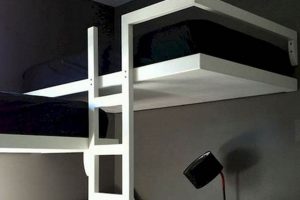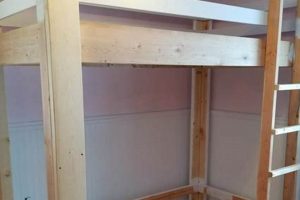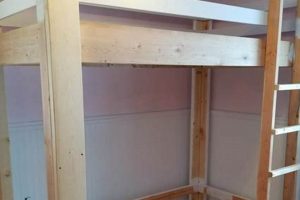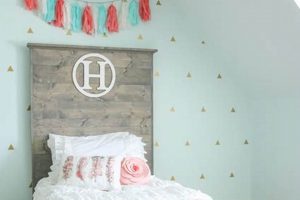A self-assembled bed covering provides a decorative and functional enhancement to a sleeping space. These structures, often made from lightweight fabrics suspended from a frame or ceiling, create an enclosed area above a bed. For example, netting draped over a circular hoop and affixed to the ceiling transforms a standard bed into a visually appealing sanctuary.
Such constructions offer several advantages. Historically, these coverings provided protection from insects and drafts. Currently, they primarily serve an aesthetic purpose, adding a touch of elegance or whimsy to a bedroom. Furthermore, they can create a sense of privacy and security, fostering a more restful sleep environment.
The following sections will explore the diverse materials, methods, and design considerations involved in crafting a personalized sleeping space enhancement. It will also cover cost-effective strategies and readily available resources to facilitate its creation.
Considerations for Bed Covering Construction
The following provides several considerations intended to improve the design and construction process of such structures. Careful planning and execution are crucial for a successful outcome.
Tip 1: Material Selection: Choose fabrics appropriate for the desired aesthetic and functionality. Lightweight materials such as tulle or voile offer a delicate appearance, while heavier fabrics like cotton or linen provide increased privacy and light blockage. Consider the fabric’s washability and durability.
Tip 2: Support Structure: Determine the method of suspension. Options include ceiling-mounted hoops, four-poster bed frames, or wall-mounted rods. Ensure the support structure is robust enough to bear the weight of the chosen fabric. Evaluate the ease of installation and aesthetic compatibility with the room’s decor.
Tip 3: Measurement Accuracy: Precise measurements are essential to ensure the fabric drapes correctly and the structure fits the bed properly. Measure the bed’s dimensions and the ceiling height accurately before purchasing materials.
Tip 4: Lighting Integration: Consider incorporating lighting elements, such as fairy lights or LED strips, to enhance the ambiance. Ensure any electrical components are safely installed and do not pose a fire hazard. Choose lights with a low heat output to prevent overheating.
Tip 5: Secure Attachment: Employ robust methods of attaching the fabric to the support structure. Sewn channels, clips, or ties can be used to create a secure and aesthetically pleasing connection. Reinforce any weak points to prevent tearing or sagging.
Tip 6: Safety Precautions: Implement fire safety measures. Use flame-retardant fabrics and avoid placing the structure near heat sources. Regularly inspect the structure for any signs of wear or damage.
Tip 7: Design Cohesion: Maintain consistency with the room’s existing decor. Select fabric colors and patterns that complement the overall style. Consider the scale of the structure in relation to the size of the room.
Adherence to these considerations facilitates the creation of a safe, aesthetically pleasing, and functional addition to a bedroom. Careful planning maximizes its beneficial attributes.
The subsequent sections will delve into specific construction techniques and offer detailed guidance on achieving professional-level results.
1. Fabric Weight Selection
The selection of fabric weight exerts a significant influence on the design and structural integrity of a self-assembled bed covering. Fabric weight, measured in grams per square meter (GSM) or ounces per square yard, directly impacts the drape, light filtration, and load exerted on the support structure. Inadequate consideration of fabric weight can lead to structural instability, unattractive draping, and compromised aesthetic appeal. For example, using a heavy velvet fabric on a lightweight wire hoop may result in sagging and potential collapse, negating the intended visual effect and presenting a safety hazard.
Conversely, opting for an excessively lightweight fabric, such as a sheer netting with a very low GSM, may provide insufficient privacy or light blockage, undermining the desired functional benefits of the bed covering. The choice should balance aesthetic preferences with practical requirements. Lighter fabrics, while offering a delicate appearance, demand more robust support systems. Conversely, heavier fabrics provide greater privacy and light control but necessitate stronger, more durable mounting hardware. The room’s ambient light and desired level of privacy also influence fabric weight selection. Bedrooms with high levels of natural light benefit from heavier, light-blocking materials, while darker rooms may accommodate lighter, more translucent fabrics.
In summary, fabric weight selection is a critical parameter in bed covering construction. It dictates the support system requirements, influences aesthetic outcome, and contributes to the overall functionality. A thorough understanding of these interdependencies is essential for achieving a safe, visually appealing, and practically effective result. Failure to properly consider fabric weight may lead to structural issues, compromised aesthetics, and a diminished sense of privacy. Therefore, careful assessment of the project’s specific requirements is paramount.
2. Support Structure Integrity
The structural integrity of the support system is paramount in the successful implementation of any self-assembled bed covering project. Its stability directly influences both the aesthetic appeal and, critically, the safety of the installation. A compromised support system can lead to collapse, damage to surrounding property, and potential injury.
- Material Strength and Load Capacity
The materials used to construct the support framework must possess sufficient strength to bear the combined weight of the fabric, any additional decorative elements (such as lights or ornaments), and potential external forces (accidental bumps or pulls). Wood, metal, and durable plastics are common choices, each with specific load-bearing characteristics. Selection should consider the intended weight distribution and the material’s resistance to bending, shearing, and compression. Inadequate material selection can result in gradual deformation or sudden failure.
- Anchoring and Mounting Methods
The method by which the support structure is affixed to the ceiling, walls, or bed frame is a critical determinant of its overall stability. Secure anchoring techniques, such as the use of appropriately sized screws, anchors, or bolts, are essential to prevent displacement or detachment. The type of mounting surface (e.g., drywall, plaster, concrete) dictates the appropriate anchoring hardware. Insufficient or improperly installed anchoring can lead to instability and potential collapse, particularly under stress.
- Design and Geometry of the Frame
The geometrical configuration of the support frame directly influences its load-bearing capacity and stability. Triangular or arched designs tend to distribute weight more efficiently than simple linear structures. The number and placement of support points also contribute to overall stability. A poorly designed frame may exhibit weaknesses at joints or stress points, leading to premature failure. Consideration of basic engineering principles is advisable in designing a robust support framework.
- Regular Inspection and Maintenance
Even with proper construction and installation, the support structure requires periodic inspection to identify any signs of wear, damage, or loosening of fasteners. Regular maintenance, such as tightening screws or replacing worn components, can prevent minor issues from escalating into major structural problems. Neglecting routine inspections can compromise the integrity of the support system over time, increasing the risk of collapse.
The interplay between material selection, anchoring methods, frame design, and maintenance practices determines the long-term reliability of the support system. Each element contributes significantly to the safety and aesthetic success of the bed covering. Prioritizing structural integrity is essential for a durable and secure installation.
3. Precise Dimension Calculation
Accurate dimensional calculation is a critical precursor to successful construction of a self-assembled bed covering. The dimensions of the bed, the desired height and projection of the covering, and the geometry of the support structure must be precisely determined to ensure proper fit and aesthetic integration. An error in these calculations can lead to a covering that is too short, too narrow, or that hangs improperly, diminishing its visual appeal and functional utility. For example, if the height of the canopy frame is miscalculated, the fabric may either drag on the floor or hang too high, disrupting the intended aesthetic effect.
Furthermore, accurate dimensioning directly impacts material usage and cost efficiency. Overestimation of fabric requirements leads to unnecessary expense and potential waste, while underestimation necessitates additional purchases and potential delays. For example, if the width of the fabric required for draping is underestimated, a second purchase, which might not perfectly match in color or texture, would be necessary. The dimensions of the room itself also require careful consideration to ensure the size and style of the structure is proportionate. A large, elaborate design might overwhelm a small bedroom, while a minimalist covering might appear insignificant in a spacious room. Proper dimensioning ensures a harmonious integration with the existing environment.
In summary, precise dimensional calculation is essential for achieving a functional, aesthetically pleasing, and cost-effective bed covering. It dictates the proper fit of the fabric, minimizes material waste, and ensures the structure complements the surrounding environment. Accurate measurements are the foundation upon which a successful construction rests, mitigating potential errors and optimizing the final outcome.
4. Secure Mounting Techniques
Secure mounting techniques are indispensable to the successful creation of a self-assembled bed canopy. These techniques directly influence the canopy’s stability, longevity, and safety. The weight of the fabric, the design of the canopy frame, and the type of mounting surface necessitate careful selection and implementation of appropriate mounting methods. For example, a lightweight canopy suspended from a plaster ceiling demands specialized anchors designed to distribute the load and prevent the fabric from tearing away. Insufficient mounting techniques can lead to structural failure, resulting in damage to the canopy, the surrounding environment, and potential injury.
Diverse mounting options exist, each suited to specific circumstances. Ceiling-mounted hooks, attached with drywall anchors or secured directly into structural beams, offer a stable suspension point for draped fabrics. Four-poster bed frames inherently provide a robust support system, requiring only the secure attachment of fabric to the frame itself. Tension rods, placed between opposing walls, can create a simple canopy frame, but their stability depends critically on the integrity of the walls and the tightness of the rod. Understanding the load-bearing capacity of each mounting method is crucial to ensure the chosen approach can safely support the canopy’s weight.
In conclusion, secure mounting techniques represent a critical element in the construction of a self-assembled bed canopy. The selection and proper implementation of these techniques directly affect the canopy’s stability, safety, and longevity. Failure to address mounting issues adequately undermines the overall project, potentially leading to hazardous conditions. Therefore, meticulous planning and careful execution of mounting procedures are essential for a successful outcome.
5. Aesthetic Compatibility Assessment
An aesthetic compatibility assessment is a fundamental phase in the creation of a self-assembled bed covering. It ensures the final product harmonizes with the pre-existing elements of the room, preventing visual discord and contributing to a cohesive and pleasing environment. Failure to conduct this assessment can result in a bed covering that clashes with the existing decor, undermining the intended aesthetic enhancement.
- Color Palette Integration
Color palette integration involves aligning the colors of the bed covering with the room’s existing color scheme. This encompasses the walls, flooring, furniture, and accent pieces. For example, a room dominated by cool blues and grays would benefit from a bed covering featuring similar hues or complementary colors like soft yellows. A starkly contrasting color could disrupt the visual balance. The assessment considers the undertones of each color to ensure seamless blending and avoid clashing combinations.
- Textural Harmony
Textural harmony refers to the balance of textures within the room’s design. The texture of the bed covering should complement the existing textures of the bedding, curtains, and other soft furnishings. A room with smooth, sleek surfaces might benefit from a bed covering with a subtle texture, such as a lightly crinkled fabric. Conversely, a room with rough, textured walls might pair well with a smoother, more refined fabric for the bed covering. Consideration of texture adds depth and visual interest to the overall design.
- Style Consistency
Maintaining style consistency involves ensuring that the bed covering aligns with the prevailing design aesthetic of the room. A minimalist bedroom, characterized by clean lines and sparse furnishings, would not be complemented by a heavily ornate or frilly bed covering. Conversely, a bohemian-style room, with its eclectic mix of patterns and textures, could accommodate a more elaborate and decorative bed covering. Aligning the style of the bed covering with the existing design language is crucial for a cohesive and harmonious result.
- Scale and Proportion Considerations
Scale and proportion refer to the relative size of the bed covering in relation to the bed and the overall dimensions of the room. A large, elaborate canopy could overwhelm a small bedroom, while a diminutive, understated covering might appear insignificant in a spacious room. The size and complexity of the bed covering should be carefully considered to ensure it complements the room’s scale and maintains visual balance. Proper proportion contributes to a sense of harmony and prevents the bed covering from appearing either too dominant or too insignificant.
These considerations demonstrate the multifaceted nature of aesthetic compatibility assessment. Integrating these facets into the design process of a self-assembled bed covering results in a visually harmonious and aesthetically pleasing space. It’s important to take a holistic approach, considering each aspect of the bedroom to ensure that the new structure looks like a natural and beautiful part of the whole.
Frequently Asked Questions
The following addresses common inquiries regarding the design, construction, and maintenance of self-assembled bed coverings. These questions are designed to clarify potential challenges and provide informed guidance.
Question 1: What is the optimal fabric for maximizing light blockage?
Dense, tightly woven fabrics such as blackout lining, heavy cotton, or velvet are most effective in minimizing light penetration. Darker colors also contribute to enhanced light blockage. Multiple layers may be used to further reduce light transmission.
Question 2: How can a canopy be securely attached to a ceiling without causing damage?
Utilizing appropriate anchors designed for the ceiling material is critical. For drywall or plaster ceilings, use drywall anchors or toggle bolts. For concrete ceilings, employ concrete screws or expansion anchors. Ensure the weight capacity of the chosen anchors exceeds the canopy’s total weight.
Question 3: What are the key considerations for fire safety when constructing a bed covering?
Flame-retardant fabrics should be prioritized. Avoid placing the canopy near heat sources or open flames. Regularly inspect the structure for any signs of wear or damage. Smoke detectors should be installed within the bedroom to provide early warning of potential fire hazards.
Question 4: How can a bed covering be effectively cleaned and maintained?
The cleaning method depends on the fabric type. Most fabrics can be vacuumed regularly to remove dust. Washable fabrics should be laundered according to the manufacturer’s instructions. Dry-cleaning may be necessary for delicate materials. Regular cleaning prevents the accumulation of allergens and maintains the fabric’s appearance.
Question 5: What are the common structural issues encountered during assembly, and how can they be mitigated?
Sagging or instability is a common issue. This can be mitigated by using a robust support structure, selecting appropriate fabric weights, and ensuring secure attachment points. Reinforcing joints and stress points can also enhance structural integrity.
Question 6: How can a bed covering be designed to enhance privacy without completely blocking airflow?
Employing layered fabrics can provide a balance between privacy and ventilation. Sheer inner layers can provide some visual screening while allowing airflow, while heavier outer layers can be closed for increased privacy when needed. Strategically placed openings can also enhance ventilation.
In summation, mindful attention to fabric selection, mounting techniques, fire safety, maintenance, structural integrity, and ventilation is essential for a successful and safe bed covering installation.
The next section provides detailed, step-by-step construction guides. Please reference accordingly.
Conclusion
This exploration has elucidated the multifaceted nature of the diy bed canopy. From initial material selection and structural considerations to precise dimensional calculations and secure mounting techniques, each aspect contributes significantly to the success and safety of the endeavor. Aesthetic compatibility, often overlooked, plays a crucial role in ensuring the final product harmonizes with the existing environment. Addressing frequently asked questions provides further clarity on potential challenges and effective solutions.
The construction of a personalized sleeping space enhancement is an undertaking that demands diligence and meticulous planning. Adherence to the principles outlined within facilitates the creation of a secure, aesthetically pleasing, and ultimately rewarding addition to the domicile. The responsibility lies with the constructor to prioritize safety and structural integrity above all else.







